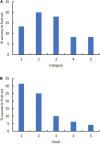Why Variation in Flower Color May Help Reproductive Success in the Endangered Australian Orchid Caladenia fulva
- PMID: 33633758
- PMCID: PMC7899986
- DOI: 10.3389/fpls.2021.599874
Why Variation in Flower Color May Help Reproductive Success in the Endangered Australian Orchid Caladenia fulva
Abstract
Caladenia fulva G.W. Carr (Tawny Spider-orchid) is a terrestrial Australian endangered orchid confined to contiguous reserves in open woodland in Victoria, Australia. Natural recruitment is poor and no confirmed pollinator has been observed in the last 30 years. Polymorphic variation in flower color complicates plans for artificial pollination, seed collection and ex situ propagation for augmentation or re-introduction. DNA sequencing showed that there was no distinction among color variants in the nuclear ribosomal internal transcribed spacer (ITS) region and the chloroplast trnT-trnF and matK regions. Also, authentic specimens of both C. fulva and Caladenia reticulata from the reserves clustered along with these variants, suggesting free interbreeding. Artificial cross-pollination in situ and assessment of seed viability further suggested that no fertility barriers existed among color variants. Natural fruit set was 15% of the population and was proportional to numbers of the different flower colors but varied with orchid patch within the population. Color modeling on spectral data suggested that a hymenopteran pollinator could discriminate visually among color variants. The similarity in fruiting success, however, suggests that flower color polymorphism may avoid pollinator habituation to specific non-rewarding flower colors. The retention of large brightly colored flowers suggests that C. fulva has maintained attractiveness to foraging insects rather than evolving to match a scarce unreliable hymenopteran sexual pollinator. These results suggest that C. fulva should be recognized as encompassing plants with these multiple flower colors, and artificial pollination should use all variants to conserve the biodiversity of the extant population.
Keywords: DNA analysis; Hymenoptera; endangered; flower color; fruit set; orchid; pollination.
Copyright © 2021 Basist, Dyer, Garcia, Raleigh and Lawrie.
Conflict of interest statement
The authors declare that the research was conducted in the absence of any commercial or financial relationships that could be construed as a potential conflict of interest.
Figures






Similar articles
-
Floral traits influencing plant attractiveness to three bee species: Consequences for plant reproductive success.Am J Bot. 2017 May;104(5):772-781. doi: 10.3732/ajb.1600405. Epub 2017 May 21. Am J Bot. 2017. PMID: 28533203
-
Colour preferences of Tetragonula carbonaria Sm. stingless bees for colour morphs of the Australian native orchid Caladenia carnea.J Comp Physiol A Neuroethol Sens Neural Behav Physiol. 2019 Jun;205(3):347-361. doi: 10.1007/s00359-019-01346-0. Epub 2019 May 29. J Comp Physiol A Neuroethol Sens Neural Behav Physiol. 2019. PMID: 31139919
-
Strong pollinator-mediated selection for increased flower brightness and contrast in a deceptive orchid.Evolution. 2016 Mar;70(3):716-24. doi: 10.1111/evo.12881. Epub 2016 Mar 4. Evolution. 2016. PMID: 26878831
-
Orchid pollination by sexual deception: pollinator perspectives.Biol Rev Camb Philos Soc. 2011 Feb;86(1):33-75. doi: 10.1111/j.1469-185X.2010.00134.x. Biol Rev Camb Philos Soc. 2011. PMID: 20377574 Review.
-
Mechanisms and evolution of deceptive pollination in orchids.Biol Rev Camb Philos Soc. 2006 May;81(2):219-35. doi: 10.1017/S1464793105006986. Biol Rev Camb Philos Soc. 2006. PMID: 16677433 Review.
Cited by
-
Anthocyanin Genes Involved in the Flower Coloration Mechanisms of Cymbidium kanran.Front Plant Sci. 2021 Oct 12;12:737815. doi: 10.3389/fpls.2021.737815. eCollection 2021. Front Plant Sci. 2021. PMID: 34712257 Free PMC article.
References
-
- Australian Government Bureau of Meteorology. (2020). Climate statistics for Australian locations. Data for weather station 079105. Available online at: http://www.bom.gov.au/climate/averages/tables/cw_079105.shtml (accessed August 9, 2020).
-
- Australian Government Department of Agriculture Water and the Environment (2018). Species profile and threats database. Available online at: http://www.environment.gov.au/cgi-bin/sprat/public/publicthreatenedlist.... (accessed August 9, 2020).
-
- Backhouse G., Jeanes J. (1995). The Orchids of Victoria. Carlton. Victoria: The Miegunyah Press.
LinkOut - more resources
Full Text Sources
Other Literature Sources
Miscellaneous

